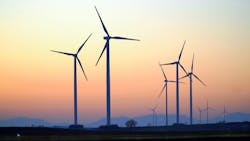Solving an Energy Crisis: Increasing Wind Energy and Upgrading Overhead Lines
South Africa could become a powerhouse of wind energy, with a study by the Centre for Scientific and Industrial Research (CSIR) concluding that over 80% of South Africa’s land has enough of a wind resource to create farms with very high annual load factors. However, the overall availability of electricity brings challenges to the region, with residents experiencing an ongoing period of widespread power shutdown. Here, Dag Kirschke, Segment Owner Wind, at global technology company, Exel Composites, discusses how upgrading overhead conductors to those with composite cores can increase wind power transmission across the grid and help solve the energy crisis.
It’s no secret that Eskom, the power utility that produces around 95% of South Africa’s electricity, has faced trouble in recent years. In numerous occurrences where demand for electricity has exceeded supply, Eskom has conducted a series of deliberate shutdowns of power in parts of the distribution system to ease the strain on the grid, known as load shedding. To ensure South Africa’s residents aren’t left in the dark as a result of unstable power, the supply of electricity must become higher and more reliable.
Wind power poses a promising option to improve energy supply, as South Africa’s approximately 3,000 kilometers of coastline provide favorable conditions for wind power generation. As an energy generation method that doesn’t produce pollutants or use any water in operation, wind power is a valuable renewable energy source. Incorporating more wind power into the grid would benefit the environment while simultaneously supplementing the overall energy supply to improve the reliability of power to residents.
The Conductor Potential
However, while wind power has the potential to generate a large amount of energy for South Africa, its transmission will be limited if the conductors carrying the electricity have a low current capacity. In order to increase the use of renewable wind energy and deliver a more reliable energy supply, power transmission across the grid must be optimized.
Conductor current capacity, also known as ampacity, is the maximum current the conductor can carry without exceeding its safe operating temperature range. All conductors have a degree of electrical resistance that causes an amount of power to be lost as heat upon transfer. This heat causes the materials in the conductor to expand, especially as metals are currently the most favored option, which can be exacerbated by hot South African weather. Expansion results in thermal sag, where the conductor lengthens and drops lower to the ground, which can cause power outages and pose a health and safety risk.
To increase power transmission across the grid safely, more conductor lines must be installed, or existing lines must be upgraded to conductors with a higher current capacity. However, installing additional conductor lines is a large and complex operation, requiring the acquisition of new land rights, passing environmental regulations, lengthy installation times, and additional labor costs. A faster and more economical solution is to upgrade the existing lines.
A Powerful Change
Power conductors consist of an outer conducting ring, most commonly made from aluminum, and a reinforcement core that provides support and strength. Traditionally, conductors are made with steel cores, known as aluminum conductor steel reinforced (ACSR) conductors. The problem with steel is that it has a high coefficient of thermal expansion, meaning ACSR conductors expand significantly when heated, causing the conductor to sag.
Because of the restricted current capacity of ACSR conductors, upgrading them to composite cored conductors should be an important infrastructure project. Composite cored conductors have a much lower coefficient of expansion than ACSRs so they can safely operate at much higher temperatures, making them high-temperature low sag (HTLS) conductors.
In fact, composite cored conductors can carry approximately twice the current of steel cored conductors at much cooler operating temperatures. They also have a much higher strength to weight ratio than steel, making the reinforcement core thinner to allow a greater proportion of aluminum in the conductor that can conduct electricity without weighing the conductor down.
Time to Upgrade
Composite cored conductors are rapidly growing in the overhead power market due to their ability to decrease thermal sag and increase power transmission. Upgrading existing lines to composite cored conductors raises the current capacity of the overhead conductors, delivering more wind power to end-users, and helping increase the transmission of electricity to residents.
Exel Composites has several decades’ experience in the electrical industry and manufactures composite cores that have a low coefficient of thermal expansion and a high strength-to-weight ratio to minimize thermal sag and maximize power transmission.
Exel’s composite cores have performed strongly in accelerated aging testing with minimal reduction in performance, and Exel can work with utilities to align with their testing needs. Our carbon fiber composite cores are produced using cost-efficient continuous manufacturing processes and can be spooled kilometers at a time while ensuring consistent quality.
South Africa naturally has great wind-harnessing potential, which could help solve the nation’s grid troubles. Now is the time to analyze the transmission and distribution network and plan any cost-efficient upgrades. Updating the lines will increase the use of wind energy and transmit more electricity to residents, keeping lights on longer for everyone.
